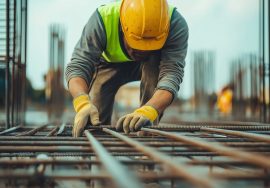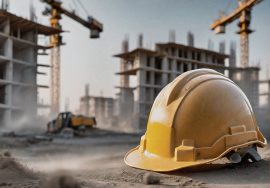Construction Consultancy: Ensuring Safety Standards on Site
Construction Consultancy: Ensuring Safety Standards on Site

Introduction
Construction Site Safety Consultancy: Construction sites are dynamic environments where safety must be prioritized to prevent accidents, protect workers, and ensure regulatory compliance. Construction consultancy services play an essential role in achieving these goals by bringing expertise in safety standards, conducting risk assessments, providing training, and ensuring ongoing compliance. This article explores how construction consultancy services contribute to safer construction sites, reduce risks, and enhance overall project quality.
The Role of Construction Consultants in Site Safety
Expertise in Safety Regulations and Compliance
Construction consultants possess specialized knowledge of local, state, and national safety regulations. They ensure that projects comply with safety standards set by organizations like the Occupational Safety and Health Administration (OSHA) and other relevant authorities. Staying updated with these regulations can be challenging for contractors, especially in complex projects. By partnering with a consultancy, construction firms can ensure full compliance, avoiding legal penalties and delays.
Developing Customized Safety Plans
Consultants conduct in-depth analyses of project requirements, location, and associated hazards to create site-specific safety plans. These plans address key concerns like material handling, equipment usage, hazardous substances, and emergency procedures, ensuring that all site-specific risks are identified and managed effectively.
Comprehensive Risk Assessment and Mitigation
Identifying Potential Hazards
Construction consultants use advanced assessment techniques to identify potential hazards associated with each unique site. These hazards range from environmental risks to operational hazards and help consultants create proactive safety measures.
Implementing Risk Mitigation Strategies
Once risks are identified, consultants design and implement strategies to mitigate them. This includes safety protocols, protective equipment, emergency plans, and clear communication procedures. By addressing potential dangers early on, consultants help reduce accident risks and establish a culture of proactive safety.
Safety Training and Continuous Education
Training Workers on Site Safety Protocols
Effective safety training is critical for preventing accidents on construction sites. Consultants design training programs that educate workers on critical topics, including the use of personal protective equipment (PPE), handling machinery, and responding to emergencies. By equipping workers with essential knowledge, consultants help minimize human error and promote a safer work environment.
Ongoing Safety Refreshers and Workshops
Safety education is an ongoing process. Regular workshops, drills, and refresher courses reinforce safety knowledge and update workers on new protocols. This continuous learning approach keeps workers vigilant and ensures that safety practices are followed consistently throughout the project.
Conducting Regular Safety Audits
Routine Inspections to Identify Safety Gaps
To maintain safety standards, consultants conduct regular site inspections, identifying any areas where safety practices may have lapsed. These audits are essential for ensuring ongoing compliance and addressing any overlooked hazards.
Documentation and Compliance Reporting
Each audit generates detailed documentation, serving as a record of safety compliance for both the client and regulatory authorities. This documentation provides essential support in case of legal inspections or accident investigations, demonstrating that the project is committed to upholding safety standards.
Emergency Preparedness and Response
Creating Comprehensive Emergency Plans
In addition to regular safety practices, consultants prepare detailed emergency response plans to handle unforeseen events like fires, equipment malfunctions, or natural disasters. These plans outline evacuation procedures, emergency contacts, and communication strategies, ensuring a well-organized response if an incident occurs.
Conducting Emergency Drills
Emergency drills simulate real-life scenarios, enabling workers to practice response procedures. These drills improve reaction times and help workers feel confident in their ability to handle emergencies effectively, ultimately reducing the potential for panic and confusion during an actual incident.
Leveraging Technology for Enhanced Safety
Integrating Advanced Safety Technologies
Construction consultancy services often leverage technology to enhance safety measures on-site. Drones, for instance, can be used to monitor site conditions, while wearable sensors can track workers’ locations and alert managers to unsafe practices. These technologies enable consultants to improve hazard detection and respond quickly to emerging risks.

Digital Documentation and Real-Time Reporting
Digital platforms streamline the documentation process, making it easier for consultants to track safety records, update protocols, and provide real-time reporting. These systems offer immediate insights into the site’s safety status, helping consultants make informed decisions that improve safety outcomes.
Fostering a Culture of Safety
Building a Safety-First Work Environment
Construction consultants play a key role in fostering a safety-first culture on-site. Through regular training, strict protocols, and leadership, consultants help promote a mindset where safety is prioritized over productivity and speed. This mindset empowers workers to be vigilant about their own safety and that of their colleagues.
Recognizing and Rewarding Safe Practices
Many construction consultants implement incentive programs to recognize safe practices on-site. Recognizing safety efforts, such as through awards or bonuses, motivates workers to continue following safety protocols and actively contribute to a safer work environment.
Conclusion – Construction Site Safety Consultancy
Construction consultancy services are essential for maintaining high safety standards on construction sites. From developing site-specific safety plans and conducting regular risk assessments to fostering a safety-first culture, consultants play a crucial role in minimizing risks and protecting workers. By ensuring regulatory compliance, providing ongoing training, and leveraging technology, construction consultancy firms help create safer construction sites and promote project success. For more information on professional consultancy services, contact NABCO IT.
External Resources – Construction Site Safety Consultancy
Indian Green Building Council (IGBC)
- The IGBC promotes sustainable building practices in India. They offer guidelines and certifications that ensure construction projects meet environmental standards. Explore their resources at Indian Green Building Council.
L&T Construction
- One of India’s largest construction and engineering companies, L&T Construction provides services including project management, cost control, and engineering consultancy. For detailed information on their offerings, visit L&T Construction.
Read more related articles to enhance your knowledge and make informed decisions
10 Essential Steps in the Building Construction Process
How to Choose the Right Materials for Your Construction Project








